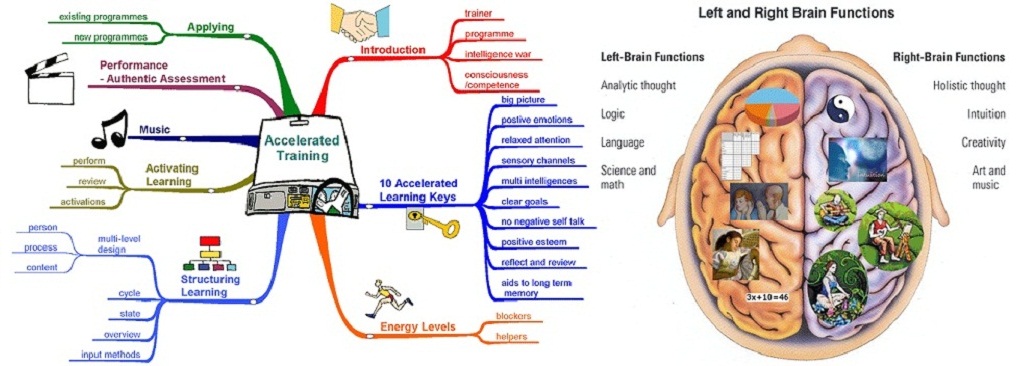Fundamentally, the concept of Accelerated Learning incorporates hands on experiences with positive reinforcement of the natural learning abilities of every individual. It's a system derived from detailed studies of the human mind and how it acquires knowledge, with consideration for Dr. Lozanov's conclusions that learning is enhanced when tension, stress, and preconceptions are removed. Accelerated Learning enables learners to move beyond limiting beliefs about themselves and what is possible, and tap into the potential they carry inside.
Lozanov believed that powerful learning must engage both the analytical brain and the emotional brain, along with both states of mind, the conscious and the unconscious. Based on these principles, IAL focuses on the following ten elements as key to successful Accelerated Learning facilitation and program design.
 | Knowledge about the Human BrainScientific knowledge and understanding of the brain supports the design of effective teaching and learning experiences. As we learn more about how the brain functions, and how that knowledge translates to classroom practices, the Accelerated Learning model adapts to integrate what we know about learning and what we do in the learning environment to support learning. |
| | |
 | Emotional StateWithout emotion, there is no learning. Our emotions powerfully influence the learning process and either hinder or enhance retention. When emotions are positive, we are open to new possibilities, our total mental capacity is available for learning, We are ready to move into new experiences. Accelerated Learning creates and maintains an environment in which each person is involved in the learning, engaged in what is happening and always feels empowered and resourceful. |
| | |
 | The Learning EnvironmentAL takes into consideration every aspect of the learning environment that can positively or negatively affect the experience, such as lighting, temperature, acoustics, seat arrangement, color, décor, as well as the emotional and mental qualities of the environment. AL creates and maintains a fun, engaging, and rewarding environment that invites learners to experiment, discover and learn. |
| | |
 | The Role of Music and the ArtsBecause music creates emotional engagement and memorability, it is a valuable, and often overlooked, educational tool. It can influence the entire pace, mood and energy level of the learning experience. Art in its various forms facilitates self-understanding, emotional involvement and the application of knowledge to real life situations. Research shows that the arts – everything from storytelling to drama, to the visual arts enhances learning and speaks to us at both the conscious and subconscious level. AL uses all of the Arts to promote the development of the entire person and make learning inspiring and transformational. |
| | |
 | Personal MotivationThe desire to continue learning is based on self-confidence, intrinsic motivation, and personal expectations. Accelerated Learning supports the intrinsic motivation of the learner as opposed to extrinsic awards like grade and prizes. In the AL classroom, learning is shared, cooperation stressed, and the learning community and group cohesion supports each individual in becoming the best they can be. By enabling learners to tap into their innermost desires, goals and vision, they naturally become engaged learners. |
| | |
 | Multiple Intelligences and Learning StylesThe theory of multiple intelligences and the many theories of individual learning and processing styles are an integral part of Accelerated Learning program design. IAL subscribes to Howard Gardner's perspective. . ."to respect the many differences among people, the multiple variations in the ways that they learn, the several modes by which they can be assessed, and the almost infinite number of ways in which they can leave a mark on the world.” |
| | |
 | Imagination/MetaphorsImaginative games and activities enrich verbal and written information with physical movement, color, depth, and positive emotions. Visualization skills enhance spelling, memory, creativity, and other abilities, and metaphors bring stronger meaning to any subject. AL uses ritual, metaphor, similies and analogies in various forms to support learning and make it more memorable. |
| | |
 | Suggestion/De-SuggestionLearners come into learning with many pre-conceptions about themselves, the world, the subject matter and learning. Personal suggestions, often called beliefs or mental models, sometimes enhance our ability to learn and often limit what is possible. In Accelerated Learning, the facilitator pays attention to each individual and supports him or her in moving beyond limitations. The AL facilitator designs the program, uses both verbal and non-verbal communication carefully and intentionally to be a supporter of learning and not an added barrier. What is not spoken may often be conveyed by body language, attitude, choice of words and thinly veiled expectations. Though subtle, positive suggestions, aided by a rich variety of learning tasks, music, movement and exercise, can create a positive mental state and raise energy levels and attentiveness. |
| | |
 | Team Learning and CooperationCooperative learning activities allow participants of all abilities to benefit as mentors and learners, develop interpersonal and time-management skills, and more fully develop their creative talents. The sharing of learning reinforces individual learning and group results. |
| | |
 | Improvement and ResultsLearning expectations should be clearly defined and shared with participants and constituents so that:
- learners are able to comprehend the relevance of the subject matter to their lives and
- facilitators of learning can measure progress and generate objective data that can be used to continuously improve and add value to planning, assessment, and process improvement.
|
